教学设计(全英文授课示范)
- 格式:docx
- 大小:26.47 KB
- 文档页数:4
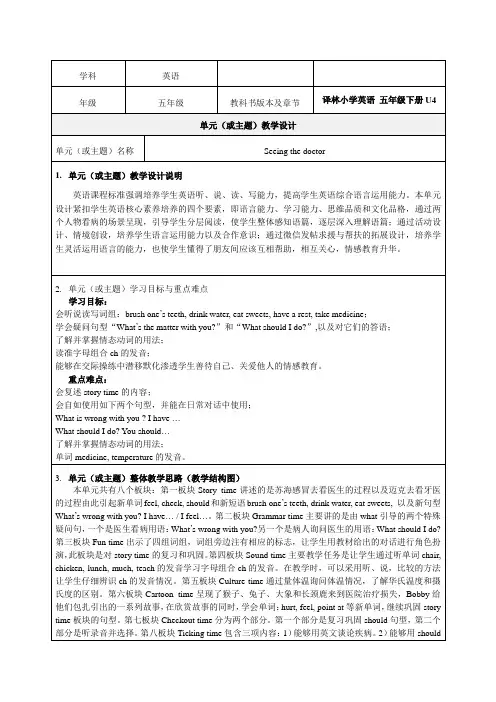
Teach: brush one’s teeth.活动意图说明:阅读部分采用的是“总分总”三层递进式阅读。
此部分我通过让学生看卡通选择,使学生整体感知课文,了解文章内容和脉络,为进一步阅读作好铺垫,打好基础。
此部分是分段阅读,通过观察苏海和麦克场景对话,呈现细节问题,让学生寻找答案,提高学生阅读能力、细节处理能力。
精阅环节的设计是三步阅读中最重要的部分,是阅读的核心环节,教师让学生阅读中划出关键词句,很好地训练学生scanning的能力,并在讲解中操练了句型,解决了生词、词组,能够切实提高阅读能力。
环节三:Step 3. Practice and Production.教的活动31. Ask and answer.T: Good reading. You did a good job. Now, It’s time to practice. Please ask and answer in pairs. You can choose Su Hai or Mike to practice.(教师首先与学生示范,归纳板书,然后让学生两人一组选取一个人物进行对话操练)2. Writing timeT: Excellent. We talk about Su hai and Mike’s illness. Give them a lot of advice. Now, It’s time to write. Please read the dialogue and fill in the blanks.Check the answers.(教师投影展示学生作品)Ask the students to show and report their writing. 学的活动31. Ask and answer.Ask and answer in pairs.(学生两人一组使用所学句型,选择人物,互相操练)Ask the students to practice.2. Writing time学生根据课文内容,综合运用本课词汇、短语,完成练笔。
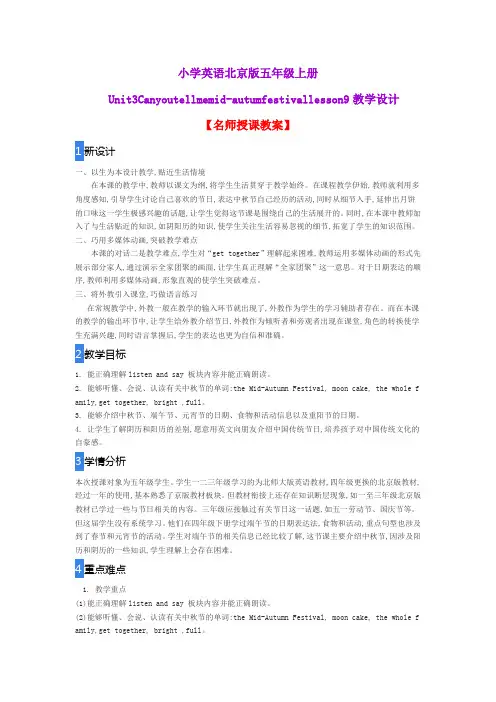
小学英语北京版五年级上册Unit3Canyoutellmemid-autumfestivallesson9教学设计【名师授课教案】1新设计一、以生为本设计教学,贴近生活情境在本课的教学中,教师以课文为纲,将学生生活贯穿于教学始终。
在课程教学伊始,教师就利用多角度感知,引导学生讨论自己喜欢的节日,表达中秋节自己经历的活动,同时从细节入手,延伸出月饼的口味这一学生极感兴趣的话题,让学生觉得这节课是围绕自己的生活展开的。
同时,在本课中教师加入了与生活贴近的知识,如阴阳历的知识,使学生关注生活容易忽视的细节,拓宽了学生的知识范围。
二、巧用多媒体动画,突破教学难点本课的对话二是教学难点,学生对“get together”理解起来困难,教师运用多媒体动画的形式先展示部分家人,通过演示全家团聚的画面,让学生真正理解“全家团聚”这一意思。
对于日期表达的顺序,教师利用多媒体动画,形象直观的使学生突破难点。
三、将外教引入课堂,巧做语言练习在常规教学中,外教一般在教学的输入环节就出现了,外教作为学生的学习辅助者存在。
而在本课的教学的输出环节中,让学生给外教介绍节日,外教作为倾听者和旁观者出现在课堂,角色的转换使学生充满兴趣,同时语言掌握后,学生的表达也更为自信和准确。
2教学目标1. 能正确理解listen and say 板块内容并能正确朗读。
2. 能够听懂、会说、认读有关中秋节的单词:the Mid-Autumn Festival, moon cake, the whole f amily,get together, bright ,full。
3. 能够介绍中秋节、端午节、元宵节的日期、食物和活动信息以及重阳节的日期。
4. 让学生了解阴历和阳历的差别,愿意用英文向朋友介绍中国传统节日,培养孩子对中国传统文化的自豪感。
3学情分析本次授课对象为五年级学生。
学生一二三年级学习的为北师大版英语教材,四年级更换的北京版教材,经过一年的使用,基本熟悉了京版教材板块。
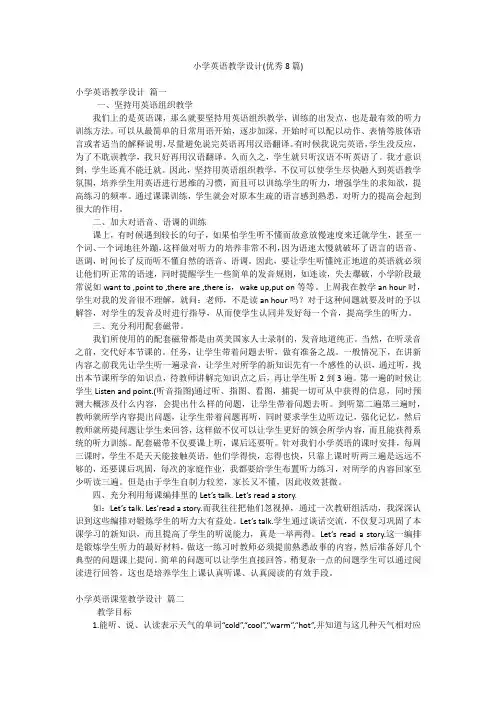
小学英语教学设计(优秀8篇)小学英语教学设计篇一一、坚持用英语组织教学我们上的是英语课,那么就要坚持用英语组织教学,训练的出发点,也是最有效的听力训练方法。
可以从最简单的日常用语开始,逐步加深,开始时可以配以动作、表情等肢体语言或者适当的解释说明,尽量避免说完英语再用汉语翻译。
有时候我说完英语,学生没反应,为了不耽误教学,我只好再用汉语翻译。
久而久之,学生就只听汉语不听英语了。
我才意识到,学生还真不能迁就。
因此,坚持用英语组织教学,不仅可以使学生尽快融入到英语教学氛围,培养学生用英语进行思维的习惯,而且可以训练学生的听力,增强学生的求知欲,提高练习的频率。
通过课课训练,学生就会对原本生疏的语言感到熟悉,对听力的提高会起到很大的作用。
二、加大对语音、语调的训练课上,有时候遇到较长的句子,如果怕学生听不懂而故意放慢速度来迁就学生,甚至一个词、一个词地往外蹦,这样做对听力的培养非常不利,因为语速太慢就破坏了语言的语音、语调,时间长了反而听不懂自然的语音、语调。
因此,要让学生听懂纯正地道的英语就必须让他们听正常的语速,同时提醒学生一些简单的发音规则,如连读,失去爆破,小学阶段最常说如want to ,point to ,there are ,there is,wake up,put on等等。
上周我在教学an hour时,学生对我的发音很不理解,就问:老师,不是读an hour吗?对于这种问题就要及时的予以解答,对学生的发音及时进行指导,从而使学生认同并发好每一个音,提高学生的听力。
三、充分利用配套磁带。
我们所使用的的配套磁带都是由英美国家人士录制的,发音地道纯正。
当然,在听录音之前,交代好本节课的。
任务,让学生带着问题去听,做有准备之战。
一般情况下,在讲新内容之前我先让学生听一遍录音,让学生对所学的新知识先有一个感性的认识,通过听,找出本节课所学的知识点,待教师讲解完知识点之后,再让学生听2到3遍。
第一遍的时候让学生Listen and point.(听音指图)通过听、指图、看图,捕捉一切可从中获得的信息,同时预测大概涉及什么内容,会提出什么样的问题,让学生带着问题去听。
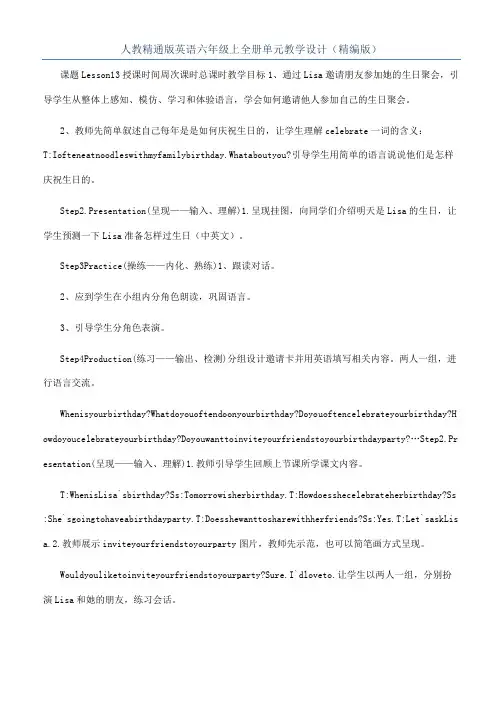
人教精通版英语六年级上全册单元教学设计(精编版)课题Lesson13授课时间周次课时总课时教学目标1、通过Lisa邀请朋友参加她的生日聚会,引导学生从整体上感知、模仿、学习和体验语言,学会如何邀请他人参加自己的生日聚会。
2、教师先简单叙述自己每年是是如何庆祝生日的,让学生理解celebrate一词的含义:T:Iofteneatnoodleswithmyfamilybirthday.Whataboutyou?引导学生用简单的语言说说他们是怎样庆祝生日的。
Step2.Presentation(呈现——输入、理解)1.呈现挂图,向同学们介绍明天是Lisa的生日,让学生预测一下Lisa准备怎样过生日(中英文)。
Step3Practice(操练——内化、熟练)1、跟读对话。
2、应到学生在小组内分角色朗读,巩固语言。
3、引导学生分角色表演。
Step4Production(练习——输出、检测)分组设计邀请卡并用英语填写相关内容。
两人一组,进行语言交流。
Whenisyourbirthday?Whatdoyouoftendoonyourbirthday?Doyouoftencelebrateyourbirthday?H owdoyoucelebrateyourbirthday?Doyouwanttoinviteyourfriendstoyourbirthdayparty?…Step2.Pr esentation(呈现——输入、理解)1.教师引导学生回顾上节课所学课文内容。
T:WhenisLisa`sbirthday?Ss:Tomorrowisherbirthday.T:Howdoesshecelebrateherbirthday?Ss :She`sgoingtohaveabirthdayparty.T:Doesshewanttosharewithherfriends?Ss:Yes.T:Let`saskLis a.2.教师展示inviteyourfriendstoyourparty图片,教师先示范,也可以简笔画方式呈现。
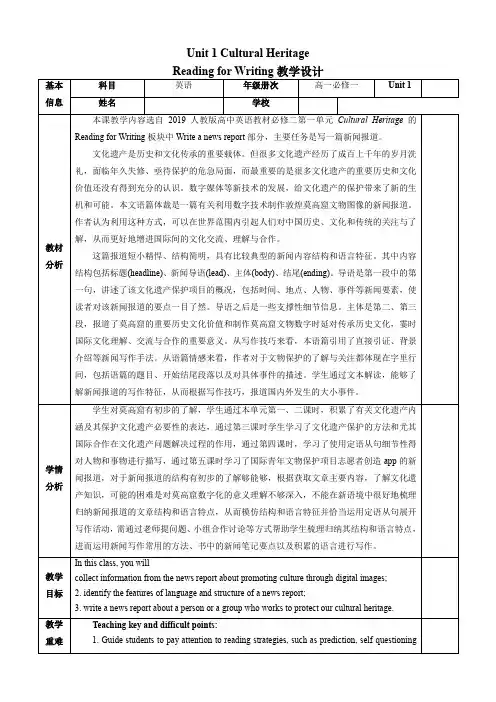
Unit 1 Cultural HeritageStep1. Lead-inT show some pictures of Mogao Caves and ask Ss what they know about them.Step2. ReadingAsk students to read the passage with some questions.Q1:What is the news report mainly about?A.Chinese researchers' contributions.B.The Mogao Caves of China.C.Highquality digital photos.D.International communication.Q2:Can you find the structure of this passage.Q3:Underline the relative clauses that the writer uses to identify the following.Q4:Read the news report and answer the questions.1.What are the researchers and scientists trying to do? What modern technology are they using?The researchers and scientists are trying to increase knowledge and appreciation of China's ancient cultural heritage.They are using digital photography to record a collection of images.2.Why are so many people interested in the Mogao Caves?Because they have long been a meeting point for different cultures and are part of the history of many countries.3.What do you think of the researcher's opinion in the last paragraph?I agree with the researcher's opinion.Understanding our own and other cultures is a great way to understand ourselves and others.Step3 :Writing你校的“绿爱”联盟( Green Love Union) 组织学生去长城进行了一次“我爱长城”的宣传活动。
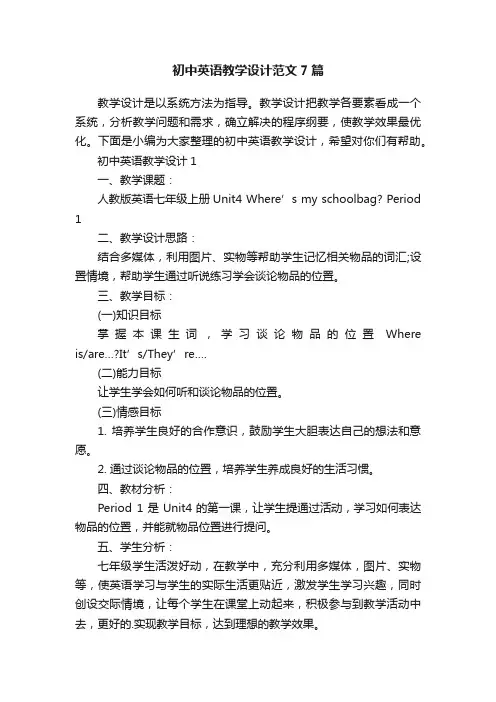
初中英语教学设计范文7篇教学设计是以系统方法为指导。
教学设计把教学各要素看成一个系统,分析教学问题和需求,确立解决的程序纲要,使教学效果最优化。
下面是小编为大家整理的初中英语教学设计,希望对你们有帮助。
初中英语教学设计1一、教学课题:人教版英语七年级上册Unit4 Where’s my schoolbag? Period 1二、教学设计思路:结合多媒体,利用图片、实物等帮助学生记忆相关物品的词汇;设置情境,帮助学生通过听说练习学会谈论物品的位置。
三、教学目标:(一)知识目标掌握本课生词,学习谈论物品的位置Where is/are…?It’s/They’re….(二)能力目标让学生学会如何听和谈论物品的位置。
(三)情感目标1. 培养学生良好的合作意识,鼓励学生大胆表达自己的想法和意愿。
2. 通过谈论物品的位置,培养学生养成良好的生活习惯。
四、教材分析:Period 1是Unit4的第一课,让学生提通过活动,学习如何表达物品的位置,并能就物品位置进行提问。
五、学生分析:七年级学生活泼好动,在教学中,充分利用多媒体,图片、实物等,使英语学习与学生的实际生活更贴近,激发学生学习兴趣,同时创设交际情境,让每个学生在课堂上动起来,积极参与到教学活动中去,更好的.实现教学目标,达到理想的教学效果。
六、重点及其突出方法:充分利用现代教育手段,创设交际情境,为学生提供图像和声音资源,进行语言操练和实践,加强学习效果。
七、难点及其突破方法:培养良好的语言表达习惯。
发挥教师良好的示范作用,注重教师在课堂教学中对学生无意识的影响。
八、教学资源:多媒体;课件;教材九、教学过程:Step anization GreetingsStep 2.Revision1. Use a pen to ask and answer between the teacher and the students, and review the key sentences in Unit3.2. Use a picture of a bag to ask students to write a lost notice and a found notice, and review the lost and found notices, then lead to the new words with the picture(1a:P19).Hold up the picture and point to the objects : table, bed , bookcase, sofa, chair, schoolbag , book, key.T: What’s this in English?S: It’s a table/bed/...Encourage or help students to read the words correctly .Write them down on the blackboard.3. Quick reaction .Let the students look at the teaching picture in 1a, finish 1a, then check students’ answers. Step3. Lead inShow my English book and my two pens, then put them on my desk. Ask students to answer the questions: “Where is my English book?” and “Where are my pens?”.Try to ask more students similar questions:Where is your pencil?...Step3.PracticeAsk the students to look at some pictures and things in the classroom and practice talking about where things are.For example:-where is my clock?-It’s on the table.Ask students to work in pairs and make conversations.Step 4.Talking about the picture(1a:P19)1. Ask the students to practice 1c in pairs.2. Let the students work in pairs and talk about where the things in the picture are on Page19 .Step 5 ListeningHave students to listen to the conversations and number the things.Check the answers . Then ask students to read the conversations after the recording.Step 6 PracticeAsk students to describe their bedrooms.For example: My cat is on the chair. My English book is on the sofa .…Step7 Summary1.--- Where is + 单数主语?… … 在哪?--- It’s under/ on/ in…它在…下面/上面/里面。
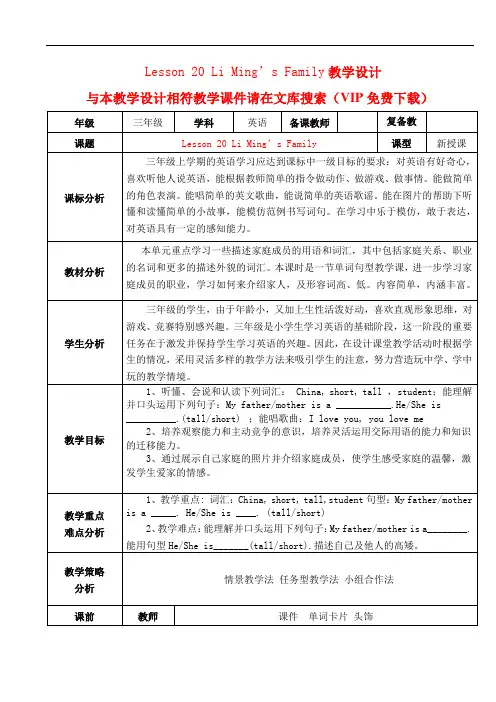
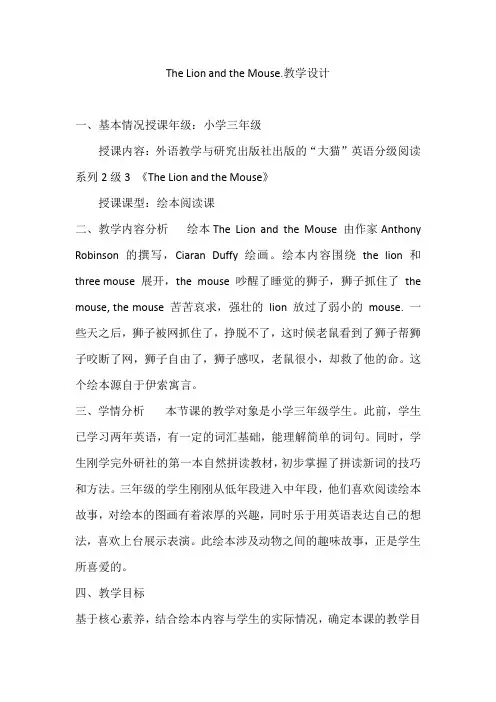
The Lion and the Mouse.教学设计一、基本情况授课年级:小学三年级授课内容:外语教学与研究出版社出版的“大猫”英语分级阅读系列2级3 《The Lion and the Mouse》授课课型:绘本阅读课二、教学内容分析绘本The Lion and the Mouse 由作家Anthony Robinson的撰写,Ciaran Duffy绘画。
绘本内容围绕the lion和three mouse展开,the mouse 吵醒了睡觉的狮子,狮子抓住了the mouse, the mouse 苦苦哀求,强壮的lion 放过了弱小的mouse. 一些天之后,狮子被网抓住了,挣脱不了,这时候老鼠看到了狮子帮狮子咬断了网,狮子自由了,狮子感叹,老鼠很小,却救了他的命。
这个绘本源自于伊索寓言。
三、学情分析本节课的教学对象是小学三年级学生。
此前,学生已学习两年英语,有一定的词汇基础,能理解简单的词句。
同时,学生刚学完外研社的第一本自然拼读教材,初步掌握了拼读新词的技巧和方法。
三年级的学生刚刚从低年段进入中年段,他们喜欢阅读绘本故事,对绘本的图画有着浓厚的兴趣,同时乐于用英语表达自己的想法,喜欢上台展示表演。
此绘本涉及动物之间的趣味故事,正是学生所喜爱的。
四、教学目标基于核心素养,结合绘本内容与学生的实际情况,确定本课的教学目标如下:(一)语言能力1、能听、说、认、读文本中的新词汇:bit, eye, free, go away, lion, mouse, net, open, play, save, sleep, small.等。
2、能模仿并表演mouse与lion之间的语言和动作。
(二)文化意识1、让学生了解绘本讲述的故事情节。
2、让学生懂得帮助他人,无论是比自己弱小还是强大的人。
(三)思维品质1、能运用视觉、听觉等方式感受和理解绘本大意并回答老师的提问。
2、能根据所学内容,结合生活实际进行思考,培养其思维能力。
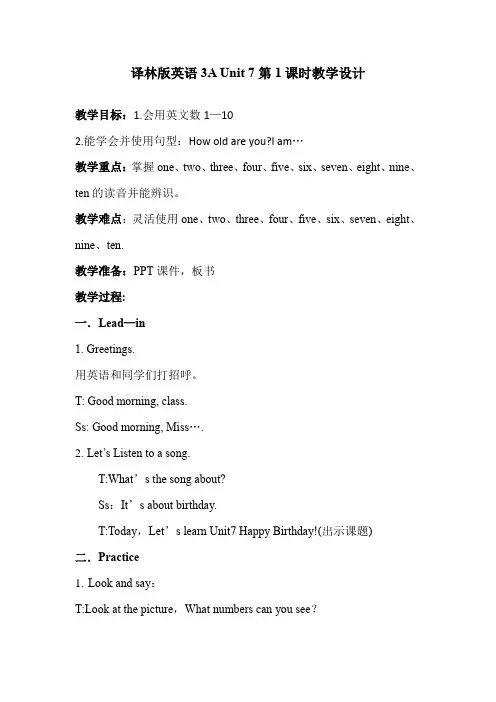
译林版英语3A Unit 7第1课时教学设计教学目标:1.会用英文数1—102.能学会并使用句型:How old are you?I am…教学重点:掌握one、two、three、four、five、six、seven、eight、nine、ten的读音并能辨识。
教学难点:灵活使用one、two、three、four、five、six、seven、eight、nine、ten.教学准备:PPT课件,板书教学过程:一.Lead—in1. Greetings.用英语和同学们打招呼。
T: Good morning, class.Ss: Good morning, Miss….2.Let’s Listen to a song.T:What’s the song about?Ss:It’s about birthday.T:Today,Let’s learn Unit7 Happy Birthday!(出示课题)二.Practice1.Look and say:T:Look at the picture,What numbers can you see?Ss:One、two、four,five、six.T:First,let’s learn Nembers!Watch the video and read after it.Read after me!Read by yourself.(设计意图:通过观看数字动画,跟读数字音频,教师带读,学生自读等多种方式帮助学生学习、记忆英文数字。
)2.Play a gameT:Now,we will play a game called “Number dinos”.When you seethe number on the dinosaur,choose the right number.T:Great!Now you know the numbers!3.Look and say:T:What number does the boy have?Ss:ThreeT:When we got things from others,what should we say?Ss:Thanks!T:What does dad have? Ss:A cake!T:Can you guess what will they have? Ss:A birthday party!T:let’s say:Come to my party! Do you like parties? Ss:…4.Read after the tape5.Let’s chant!6.Look and say:T:Where are they?Ss:In a cake shop.(看Lead in的第二幅图,预测文本)T:What do they want to buy?Ss:Maybe a cake.T:What numbers can you see?Ss:seven、eight、nine、ten.7.Guess:T:What will they do after buying the cake?(猜测文本发展)Ss:Maybe have a birthday party!三.Summary1.T:当我们询问对方年龄的时候,可以问:Ss:How old are you?T:回答用:Ss:I am ….3.根据情境,完成对话,练习总结的句型。
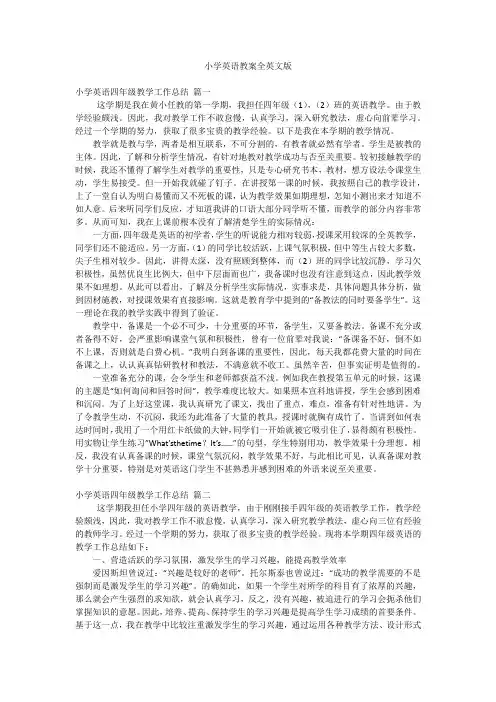
小学英语教案全英文版小学英语四年级教学工作总结篇一这学期是我在黄小任教的第一学期,我担任四年级(1),(2)班的英语教学。
由于教学经验颇浅。
因此,我对教学工作不敢怠慢,认真学习,深入研究教法,虚心向前辈学习。
经过一个学期的努力,获取了很多宝贵的教学经验。
以下是我在本学期的教学情况。
教学就是教与学,两者是相互联系,不可分割的,有教者就必然有学者。
学生是被教的主体。
因此,了解和分析学生情况,有针对地教对教学成功与否至关重要。
较初接触教学的时候,我还不懂得了解学生对教学的重要性,只是专心研究书本,教材,想方设法令课堂生动,学生易接受。
但一开始我就碰了钉子。
在讲授第一课的时候,我按照自己的教学设计,上了一堂自认为明白易懂而又不死板的课,认为教学效果如期理想,怎知小测出来才知道不如人意。
后来听同学们反应,才知道我讲的口语大部分同学听不懂,而教学的部分内容非常多。
从而可知,我在上课前根本没有了解清楚学生的实际情况:一方面,四年级是英语的初学者,学生的听说能力相对较弱,授课采用较深的全英教学,同学们还不能适应。
另一方面,(1)的同学比较活跃,上课气氛积极,但中等生占较大多数,尖子生相对较少。
因此,讲得太深,没有照顾到整体,而(2)班的同学比较沉静,学习欠积极性,虽然优良生比例大,但中下层面而也广,我备课时也没有注意到这点,因此教学效果不如理想。
从此可以看出,了解及分析学生实际情况,实事求是,具体问题具体分析,做到因材施教,对授课效果有直接影响。
这就是教育学中提到的“备教法的同时要备学生”。
这一理论在我的教学实践中得到了验证。
教学中,备课是一个必不可少,十分重要的环节,备学生,又要备教法。
备课不充分或者备得不好,会严重影响课堂气氛和积极性,曾有一位前辈对我说:“备课备不好,倒不如不上课,否则就是白费心机。
”我明白到备课的重要性,因此,每天我都花费大量的时间在备课之上,认认真真钻研教材和教法,不满意就不收工。
虽然辛苦,但事实证明是值得的。
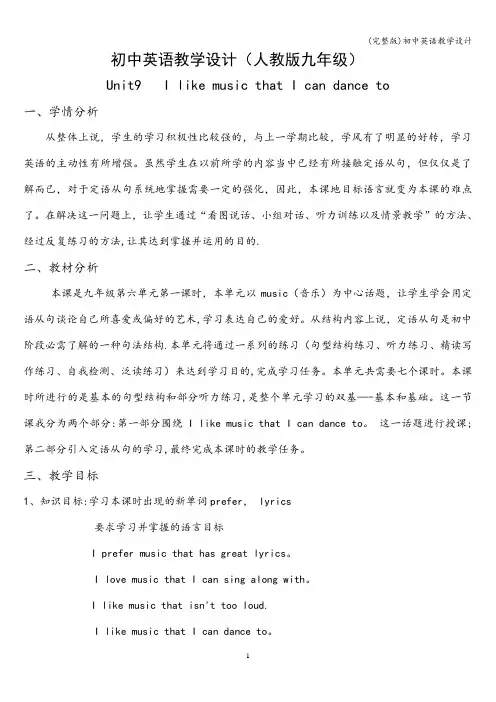
初中英语教学设计(人教版九年级)Unit9 I like music that I can dance to一、学情分析从整体上说,学生的学习积极性比较强的,与上一学期比较,学风有了明显的好转,学习英语的主动性有所增强。
虽然学生在以前所学的内容当中已经有所接触定语从句,但仅仅是了解而已,对于定语从句系统地掌握需要一定的强化,因此,本课地目标语言就变为本课的难点了。
在解决这一问题上,让学生通过“看图说话、小组对话、听力训练以及情景教学”的方法、经过反复练习的方法,让其达到掌握并运用的目的.二、教材分析本课是九年级第六单元第一课时,本单元以music(音乐)为中心话题,让学生学会用定语从句谈论自己所喜爱或偏好的艺术,学习表达自己的爱好。
从结构内容上说,定语从句是初中阶段必需了解的一种句法结构.本单元将通过一系列的练习(句型结构练习、听力练习、精读写作练习、自我检测、泛读练习)来达到学习目的,完成学习任务。
本单元共需要七个课时。
本课时所进行的是基本的句型结构和部分听力练习,是整个单元学习的双基—-基本和基础。
这一节课我分为两个部分:第一部分围绕I like music that I can dance to。
这一话题进行授课;第二部分引入定语从句的学习,最终完成本课时的教学任务。
三、教学目标1、知识目标:学习本课时出现的新单词prefer, lyrics要求学习并掌握的语言目标I prefer music that has great lyrics。
I love music that I can sing along with。
I like music that isn't too loud.I like music that I can dance to。
2、能力目标:能够对关系代词引导的定语从句的灵活运用,这也将是本节课的重点和难点学习。
3、情感目标:让学生学会用定语从句谈论自己所喜爱或偏好的艺术,学习表达自己的爱好.四、教学过程Step1 导入1、音乐导入。
初中英文教学设计初中英文教学设计模板(精选5篇)作为一位无私奉献的人民教师,时常需要编写教学设计,借助教学设计可以提高教学质量,收到预期的教学效果。
你知道什么样的教学设计才能切实有效地帮助到我们吗?以下是店铺精心整理的初中英文教学设计模板,欢迎大家借鉴与参考,希望对大家有所帮助。
初中英文教学设计篇1教学目标:1、能听懂、会说、会读、会拼写词汇look for, join, study2、能听懂、会说、会读日常交际用语和句型Classes are over. Perhaps they are. I’ll go and join them. Where are you going? I’m going to …3、培养学生乐于助人的良好思想品质。
重点难点:1、四会掌握词汇和句型。
2、能正确理解掌握并运用日常交际用语。
教学过程:首先是准备环节。
在这一环节,老师与学生交谈彼此的爱好,在轻松愉快的氛围中,拉近老师与学生之间的距离,为新授课的学习打下良好的铺垫。
其次是复习兼新授(单词与句型的学习)环节。
这一环节包括两个步骤,一通过看动画图片来复习“现在进行时”的特殊疑问句,帮助学生进入这一时态的学习而做好准备。
二以“猜猜看”的游戏来帮助学生重温了“现在进行时”的一般疑问句,在这个过程中引出新单词和句型的学习并进行相应的操练,提前把课文中的难点解决掉,为下面的课文学习扫除障碍。
接着是课文学习环节。
通过观看课文动画片,让学生做相应的练习来理解和学习朗读课文。
然后是巩固环节。
这个环节分三步,第一步是以不同的方式来让学生熟读课文。
第二步是训练培养学生听的能力,完成练习“Listen and match”。
第三步是训练培养学生写的能力,完成练习“Look, read and complete”。
初中英文教学设计篇2一、教学目标:1. 语言知识目标:1) 能掌握以下单词: rain, windy, cloudy, sunny, snow, weather, cook, bad, park,message, take a message, could, back, problem 能掌握以下句型:① —How's the weather in Beijing?—It's sunny.② —Can I take a message for him?—Yes. Could you just tell him to call me back?—Sure, no problem.2) 能用所学的知识描述天气情况。
人教PEP 版五年级英语上册教学设计Recycle 1一、单元整体分析本单元是人教版英语五年级上册复习一单元,围绕“1~3 单元的核心句型”展开话题。
本单元以陈杰参观Willow 小学为线索,把已经学过的语言知识有机地融合在一起,并通过不同类型的任务,帮助学生复习和巩固语言,培养学生综合运用语言的能力以及自主学习能力。
分两个课时完成。
第一课时包括P32-P33 的教学内容,第一课时通过陈杰与David, Jean 和Dean 的对话为场景,让学生在新的语境中复习核心词汇和句型的语义及语用情景。
第二课时P34-P35 的教学内容,P34 通过陈杰在学校餐厅点餐的场景及角色扮演活动复习了第三单元的核心词汇和句型。
P35 包括三个活动,综合复习了1~3 单元的核心句型、词汇及语音知识。
在课堂教学中,首先要整体把握本单元教学内容,根据学生学情,把握教学重点和教学难点,然后围绕本单元主题展开教学设计。
要让学生充分理解和运用这些句型。
教师要通过图片展示,借助实物等直观的教学手段,完成真实的任务与活动增强学生对语言的感受。
随着学习内容的扩展,教师要有意识、有计划地培养学生阅读理解和说话、连词成句的能力,增强学生的自信心,帮助学生克服学习中的畏难情绪。
本单元所需要掌握的语音、句型在1~3 单元已经学过,学生们有了一定的基础,但是语言的综合运用方面学生们还需要掌握。
二、单元教学目标1.知识目标(1)能够听、说、认读1~3 单元有关有关人物性格、外貌特征、品质、一周七天名称的表达及各类食品等词汇。
(2)能够掌握1~3 单元语音版块重点字母和字母组合的发音规则。
(3)能够听、说、认读4~6 单元的核心句型:--What’s she/he like?-- Is she/he…?-- She is kind/….-- What do you have on…?-- I have …(介绍一周课程)2.能力目标(1)能够听、说、读、写,并在实际情景中运用1~3 单元关于关人物性格、外貌特征、品质、一周七天名称的表达及各类食品等词汇。
Lesson2 教学设计一、教学内容与分析1. Just practise本局部以红色和蓝色文字呈现出本课书的主要目标语言What did you do during your holidays通过图画和文字相结合的方式呈现出需要听、说、认读的动词短语:go to the beach, enjoy sunbathing, enjoy the moon and stars, at night, stay at home, have a party, enjoy Spring Festival。
可以通过师生之间、生生之间相互分享假日经历,鼓励学生主动感知、模仿、学习和体验,引导学生能够运用What did you do during your holidays I went to ...等表示询问和介绍的语句在真实语境中进行交际。
主要目标语言:What did you do during your holidays I went to Sanya.2. Just write本局部重点教学词汇和句型。
通过师生创设的真实语境,能够听、说、读以及在四线格中标准地书写单词或短语sun, moon, star, by plane, at night, at home以及句子What did you do during your holidays此外,本局部的设计重在对目标词汇、目标语句的交际运用。
3. Let’s interview本局部通过提供中国地图以及六座城市的场景图让学生在了解、欣赏我们美丽祖国风光的同时,运用相关功能语句What did you do during your holidays I went to ...进行会话交际,从而引导学生在交流活动中正确运用动词过去式表达过去的旅行经历。
4. Let’s chant本局部设计了一首有节奏的chant,学生在学习并说唱歌谣的过程中,自然感悟字母组合ng在单词interesting, playing, exciting, travelling 中的发音,并总结出ng在单词中的读音规律。
Unit 4 Where is my schoolbag? 教学设计xx中学xxx一、教学内容本单元以谈论物品位置(Things around the house)为话题,要求学生学会方位介词on, in, under, behind等的用法。
题材颇具现代气息,贴近学生日常生活,内容丰富,词汇量大,通过描述物品位置、找寻物品、设置理想化居室等系列活动,让学生在听、说、读、写、做中学习语言知识,培养运用语言知识的能力,激发创新精神。
而本节课在这个单元中对于物品方位的初步认知和表达起着重要的作用,主要通过问答方式教授学生如何表达单复数物品简单的方位。
二、语言结构1.句型:Where is/are …?It is/They are ….2. 方位介词on, in, under, behind等的用法3. 名词的复数形式三、教学重点、难点1. 方位介词in, on, under behind的用法2.Where的特殊疑问句及其回答。
3.新单词bed, table, bookcase…四、单元教学目标1.知识目标(1)掌握新单词(2)熟练运用介词in, on, under(3)熟练运用where问句及其回答(4)掌握名词单复数及人称代词they的用法2.能力目标(1)学会用英语询问自己的和他人的物品的具体位置(2)学会用英语准确描述物品的具体位置3.情感目标(1)培养学生整齐摆放自己物品的生活习惯(2)通过小组对话、讨论等一系列的课堂活动,培养学生的合作精神五、教学方法和学习策略(1)交际策略: 学会与他人合作交流,并能把语言材料用到真实的生活中去(2)资源策略:学会利用一切可利用的学习资源如词典,书等来获取更多的学习信息六、课时安排六课时七、教学过程设计Period 1I. 教学目标1. 知识目标1)单词:Bedroom bed(s) schoolbag sitting room table chairs sofa table chairs books bookcase2)句型: Where is/are …?It is/They are ….2.能力目标Use English to talk about the position of thingsII. 教学重点掌握重点单词和询问物品的位置III. 教学难点1.正确使用介词in on under behind2.名词的单复数变化及谓语动词的变化IV. 教学设计Step1. Lead-inPlay the flash and have students sing along with it. Tell them to clap their hands if they would like to.Step2. Learn the new wordsShow the pictures of furniture, learn the new words.T: What is this?Ss: It is a …Step3. GuessShow a picture of box,and ask students to guess: Where is the cat?If they have correct answers. Encourage them.Step4. PresentationShow a picture of room, have students use the target language to make a dialogue.For example:T: Where is my schoolbag?S: It’s on the table2.S: Where’s my pencil?S:It’s in the schoolbag3. T: Where are my keys ?S: They’re on the chair(红色的地方老师要强调,单数要用is复数要用are) Step 5. Finish 1aHave students read these words again and finish 1a. Match the words with the pictures.(Keys: b e h g d a, f c)Step 6. 听力练习1b.Listen carefully and number the things in the picture 1-4. Check the answers. Step 7. Summary and HomeworkThis class we talk about where things are, everyone has a good job, after class, please talk about them with your family members. Don’t forgetyou’re your things in a correct order.Step 8: Blackboard designUnit4 Where is my school bag?Section A 1a-1c1 Key vocabulary: where 、table、bed 、chair、on under、bookcase、sofa2 Target languageWhere‘s the/my …? (Where‘s=Where is)It’s/ on/in/under the ….Where are the/my …?They’re on/in/under the …. (They’re=They are) 3.区分:cat bat mat hatUnit 4 Where is my schoolbag? 教学设计一、教学内容本单元以谈论物品位置(Things around the house)为话题,要求学生学会方位介词on, in, under, behind等的用法。
武汉东湖学院大学英语部第二教研室 周婧丹 1 Unit 3
Why do we believe that the earth is round? About the Text Introduction At the very beginning you may find this title is rather ridiculous because everybody knows that the earth is round. No one bothers to think twice about this question. Have you ever thought that the earth is in another shape? The answer is definitely “no”. Because we were born to be told that the earth is round. But in ancient times, the common belief was that the sky is round and the earth is flat. Just imagine if you are not informed the shape of the earth by experts, it is very likely that you think the same way as the ancient people did.Perhaps, some of you may protest in class that it is really a waste of time to discuss the question whether the earth is round or not. It’s meaningless; it has already been a proven fact. But if you have previewed this text, you must know that the real interest of the author is not in the debate of whether the earth is round or not. Instead, he hopes to draw our attention to a very serious fact that nowadays people become more gullible than ever before with the purpose to make us reexamine our thinking habits. Otherwise we can never becomeanintellectual independent person. In order to help you better understand this unit, I’d like to ask you to participate in three tasks. The first task is that you are going to figure out the sources of our knowledge and we together analyze the advantages and disadvantages of those different sources of our knowledge. The second task is that you are going to figure out the evidences the author provided to prove that the earth is round as well as the opposite arguments that are proposed by the oval earthman. The third task is that we are going to discuss the conclusion that is drawn from this unit and further explore some thinking skills which are needed to help us become an intellectual independent person.
Task 1 Brainstorming (Where does our knowledge come from?) Students are divided into 4 groups. A representative should be elected to write down their ideas on the blackboard. The source of our knowledge Indirect source: Traditional media: Books, newspapers, magazines etc. 武汉东湖学院大学英语部第二教研室 周婧丹 2 New media: Radio, TV, internet Teachers, experts, parents, friends, colleagues, classmates Advantages: Easily available, more convenient Disadvantages: Not reliable sometimes, make us overloaded with information Direct source: Self-experience, self-observation, self-experiment Advantages: More reliable Disadvantages: time-consuming, energy-consuming
Q: Should we believe everything experts tell us? As average men, we are often overloaded with both information and misinformation and cannot suitably process and assimilate what we receive. We tend to regard what we hear and read as true without factual verification or the test of reason. According to the author, though we should respect the viewpoints of true experts, we should try to test their theories before we accept them, and should compare different viewpoints to arrive at a truer perspective. This may pose us a great dilemma. On one hand, we haven’t enough time and energy or we are not qualified to explore everything on our own to get first-hand experience, on the other hand the indirect sources of knowledge are sometimes not reliable and they are overloaded. What shall we do? I think we’ll leave this question to task 3. And in that part we’ll discuss in depth about some thinking skills to deal with this kind of dilemma.
Task 2 Find some evidences that the author figure out to prove that the earth is round. The author’s evidences If you stand by the seashore on a clear day, you can see the masts and funnels of invisible ships passing along the horizon. This phenomenon can only be explained by assuming that the earth's surface is curved. (The phenomenon of invisible ships.) Analogy of the sun and moon. The earth’s shadow: When cast on the moon during eclipses, it appears to be the shadow of a round object. The Astronomer Royal, who ought to know, tells me that the earth is round. The astronomers can foretell eclipses, and this suggests that their opinions about the solar system are pretty sound. Navigation. People can sail ship round the world, and reach the places they aim at, by calculations which assume that the earth is spherical. Q:Why does the author think the evidences are precarious? Because those evidences are subject to objection and can be challenged easily. The opposite arguments proposed by oval earthman also seem reasonable.